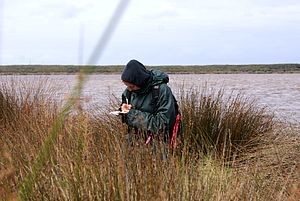 Repeat visits to the same site may be necessary to find all species, particularly areas prone to seasonal change such as lagoon margins. Photo: Jesse BythellThere are various ways to compile a plant list for a site (when not part of a standardised vegetation survey). A list can be compiled simply by recording all the species seen during a visit to a site. Alternatively a more systematic approach may be taken as follows.
Repeat visits to the same site may be necessary to find all species, particularly areas prone to seasonal change such as lagoon margins. Photo: Jesse BythellThere are various ways to compile a plant list for a site (when not part of a standardised vegetation survey). A list can be compiled simply by recording all the species seen during a visit to a site. Alternatively a more systematic approach may be taken as follows.
Complete a survey of the boundary of the area, followed by at least two
traverses across the site at right angles to the main topographical features. Where there are no clear features to traverse, the search should follow a figure of eight path. Larger areas should be subdivided into smaller search areas for which separate plant lists can be prepared.
Several visits should be made to an area at different times of the year as some species are not always visible. Some species can be identified reliably only at certain times. Identification of some species such as sun orchids (Thelymitra sp.) may be possible only at certain times of the day and therefore surveyors should consider this as they plan fieldwork.
When preparing plant lists for private land it is essential you gain permission from the landowner to compile and share the list.
What to record?
The following information should be provided with each plant list:
- The year and date when the list was compiled.
- The search effort (an indication of the number of people who visited the area and the time spent in the field searching for plants)
- The names of people involved in preparing the list (get permision from all participants to include them as contributors).
- A map showing the area that was searched and for which the plant checklist was prepared.
- The central grid reference of the area searched.
- For each listed taxon an indication of its abundance (common, uncommon, or specify the number of individual plants seen).
- The location of any herbarium vouchers for any of the plant taxa recorded.
- An explanation of any abbreviations used in the list (e.g., unc. = uncommon)
The following structural, functional or taxonomic classes may be used for grouping species in a list:
Conifers; monocotyledon trees and shrubs; dicotyledon trees and shrubs; monocotyledon lianes; dicotyledon lianes; lycopods (clubmosses) and psilopsids (fossil ferns); ferns; orchids; grasses; sedges; rushes; monocotyledon herbs (other than orchids, grasses, sedges and rushes); composite herbs; dicotyledon herbs (other than composites); adventives. Species should be listed alphabetically within each group.
Alternatively, list species in alphabetical order without groups. Exotic species
are commonly indicated by an asterisk and can be listed either among the
indigenous species or separately.
Occurrences of plant species recorded previously should be cited when they have not been seen during a survey. Records of previous visitors should be clearly identified on the list. When old records are included, then the following information should be provided: the name of the person who recorded the plant previously at the site; the date of the observation; and a citation of the reference to that record (or the herbarium specimen).
